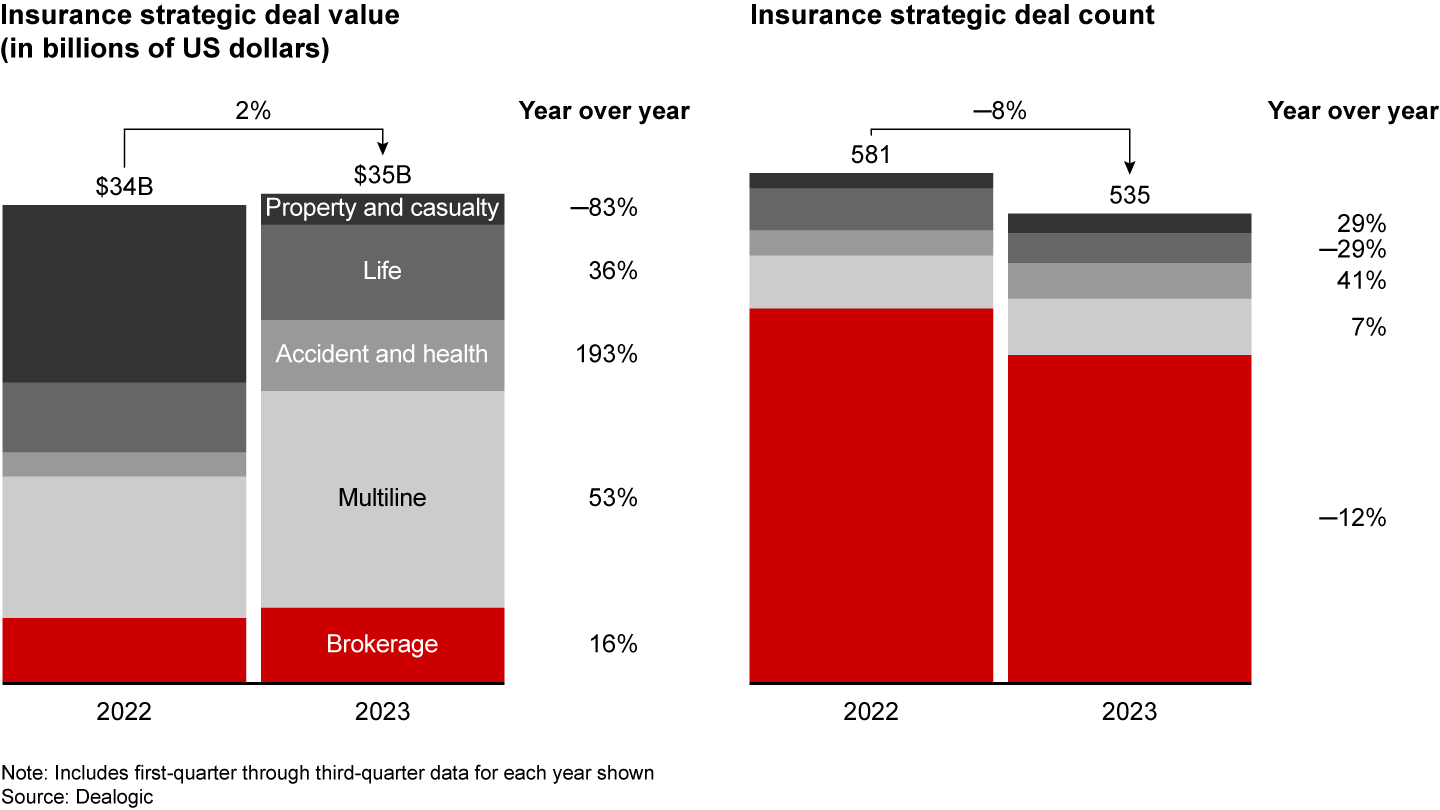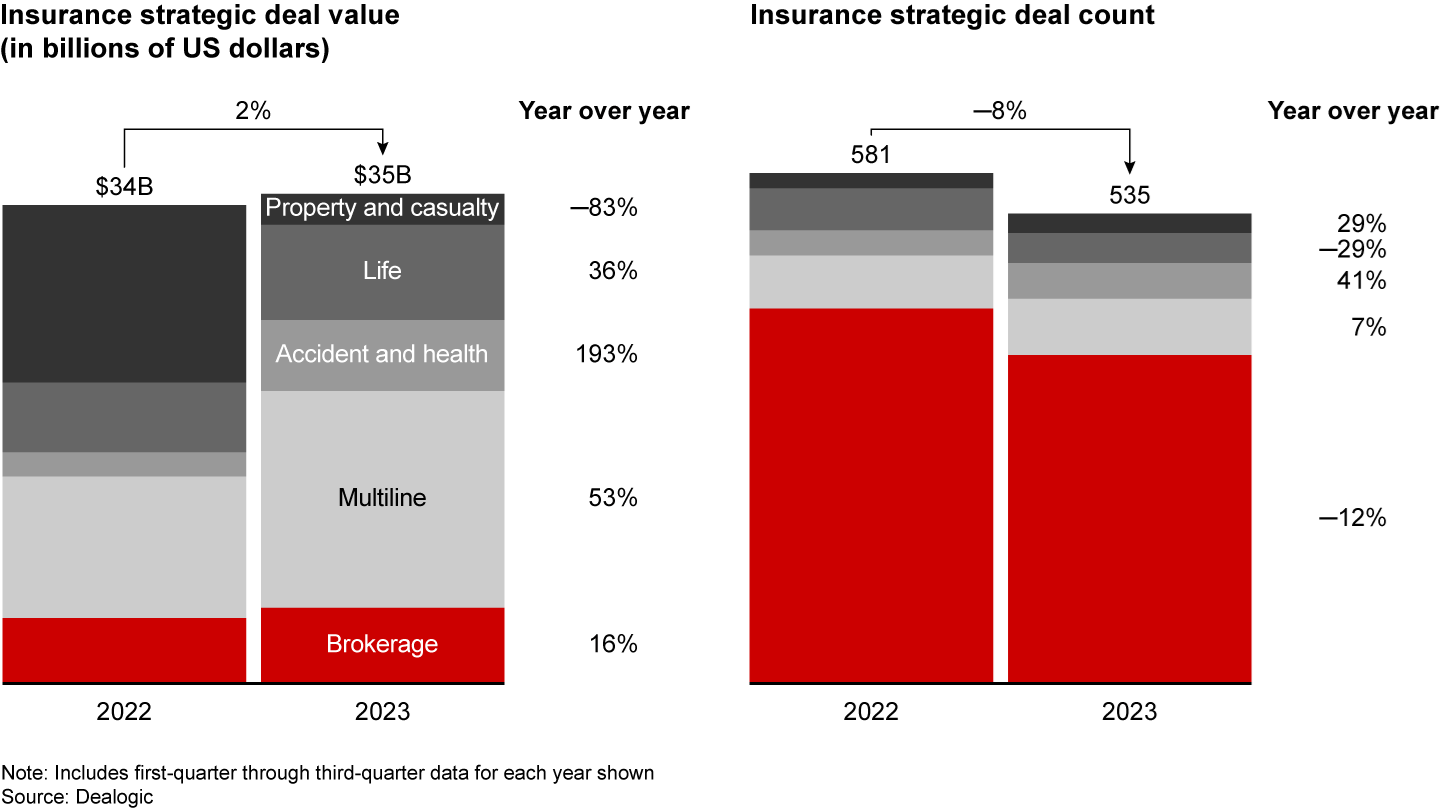M&A Report

At a Glance
- Even as dealmaking slowed in 2023, many insurance companies continued to use M&A to strengthen positions or improve offerings.
- Targeting new technologies to enhance core insurance capabilities is helping some companies stay ahead.
- Others are turning to acquisitions that enable greater focus on prevention in addition to protection.
- Partnerships are becoming common as insurers test new waters, but they require as much preparation as acquisitions.
This article is part of Bain's 2024 M&A Report.
Dealmaking slowed in 2023 for the insurance industry amid the same macroeconomic concerns that caused activity to stall across most other industries. Deal value grew 2% while deal volume fell by 8% over the first three quarters of the year compared with the same period a year earlier (see Figure 1). Despite the slowdown, some insurance carriers, especially diversified global companies, continued to use M&A to hone and strengthen positions in specific markets. That was the objective of HDI’s acquisition of Liberty Mutual’s business in selected South American markets, for example.


In life insurance, in which the number of deals dropped by nearly 30% over the first three quarters of 2023, private equity firms and large asset managers continued to invest in assets in North America to the tune of $7 billion. Deal activity dropped for property and casualty insurers, too, with 30% of the segment’s 2023 deals classified as minority deals vs. 15% in 2020. And in brokerages, which represent more than 70% of industry deal volume, activity slowed by 12% in the first three quarters of 2023 compared with the same period in 2022. In this segment, serial acquirers also are shifting focus from purely growing scale through deals to driving scale efficiencies and effectiveness through a higher degree of integration.
Acrisure, now a top 10 global brokerage built through more than 700 acquisitions over the past decade, has launched the next level of integrating its acquisitions at the enterprise stage by starting to operate under a single brand and rolling out unified regional platforms while at the same time continuing to use acquisitions to build further scale and scope.
There are two underlying themes over the past 12 months’ deal activity that will help show where the industry is heading and the role that M&A will play: One set of deals strategically enhanced the core by providing access to technology that advances insurance capabilities; another set reflects the increasing focus on prevention in addition to protection.
Consider the targeted deals made by Allianz to acquire new technologies that enhance its core insurance capabilities. For instance, the company’s Allianz X division bought claims technology provider Innovation Group in the UK this year, building on last year’s deal to take full control of simplesurance, a provider of cross-selling technology that is closely cooperating with Allianz partners.
The other impetus for dealmaking is increasing consumer demand for risk prevention services from insurers (see Figure 2). Climate change, disease, aging populations, and technological disruptions are combining to radically change the risk landscape—both through increased frequency of events and an ever-expanding set of perils. The changes thrust insurance companies into new roles. They have the opportunity to evolve beyond managing reimbursement and repair for damage into working toward preventing or minimizing losses. This includes both incentivizing behaviors that will reduce risks as well as increasing the use of technologies such as water sensors, water shut-off valves, and related tools (see the Bain Brief “The Future of Insurance: As Risks Mount, Insurers Aim to Augment Protection with Prevention”).
Companies that traditionally built their competitive advantage around underwriting risk and operational excellence increasingly are moving to extend their offerings beyond risk protection to address key pain points across the customer journey, such as risk prevention services. In doing so, they face the inevitable build, buy, or partner decision. We see different players pursuing different paths. HUK-Coburg, Germany’s leading auto insurance carrier, has embarked on a strategy to build value-added services across the whole car ownership customer journey, including offering telematics-based insurance products, establishing a national network of affiliated auto repair shops, and operating used car dealerships.
More insurers are opting to buy or partner for services that go beyond the traditional insurance value chain. For example, over the past two years, US property and casualty insurer State Farm became an equity participant in multiple companies that offer prevention services around auto, home, and cyber insurance. Among the biggest deals were State Farm’s equity investments in home security technology provider ADT and in cyber software provider Elpha Secure Technology.
Additionally, more companies are opting for partnerships as they test new waters. After a successful pilot, leading Swedish insurer Länsförsäkringar rolled out a water leakage detection solution produced by Ondo, an insurtech with which it has engaged in a five-year partnership. The move helps to transition the insurer to a “predict and prevent” claims prevention model. Similarly, AXA XL partnered with Intenseye to use the company’s AI-powered technology to prevent workplace injuries. Employee health and safety teams rely on the technology to monitor facilities for potential health and safety violations.
Equity investments, either via minority stakes or full acquisitions, require much rigor regarding due diligence for the deal and the asset itself, with dealmakers considering both financial and business aspects before making the decision to invest. For these deals, it is critical to involve the relevant line of business in the process right from the start because a key part of the deal thesis and anticipated value-add are rooted in the ability to integrate the service into the core insurance offering.
Partnerships come with much promise but also the danger of being driven more from a marketing perspective than a nailed-down value creation plan. It’s easy to sign up a partner in a headline deal, but it’s a lot harder to effectively integrate it into the business. Unclear roles and decision rights among partners can also introduce new management complexities. The best companies support partnerships with the same disciplined preparation that they would apply to an acquisition, and they invest upfront in proper governance for a smoother collaboration.